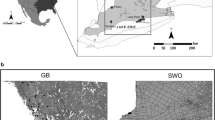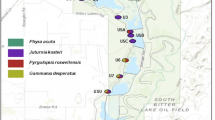Abstract
The mangrove salt marsh snake (Nerodia clarkii compressicauda) occupies a unique and disappearing habitat in much of coastal southern Florida. Given extensive habitat fragmentation and high predation pressure in open spaces, it seems likely that populations of N. c. compressicauda consist of isolated groups of related individuals. To assess the degree of population subdivision in this species we genotyped a total of 125 individuals from seven locations along the Florida coast at four microsatellite loci. Overall heterozygosity was moderate (57.7%) and somewhat lower than that seen in other snake species. Population subdivision was particularly pronounced with 19 of 21 sample pair-wise ΦST values significantly different from zero and ranging from 0.064 to 0.343 (P ≤ 0.05). About 11 of 39 alleles were private alleles that also tended to be in high frequency in the populations where they occurred (average frequency ~27%). The correlation of genetic and geographic distances was highly significant and positive (r 2 = 0.8733 and P < 0.001) with ΦST increasing by ~0.01 for every 10 km of separation. Overall, salt marsh snake populations appear to be fractured into isolated neighborhoods on the order of 50–80 km. In spite of its apparent local abundance, we believe that N. c. compressicauda is in need of conservation protection. The combination of extremely low dispersal, narrow habitat requirements, and most importantly, extensive habitat alteration resulting from coastal real estate development may mean that N. c. compressicauda is highly susceptible to population extirpation and potentially extinction.


Similar content being viewed by others
References
Ausubel FM, Brent R, Kingston RE, Moore DD, Seidmen JG, Smith JA, Struhl K, Wang-Iverson P, Bonitz SG (1993) Current protocols in molecular biology. Greene Publishing Associates and Wiley-Interscience, New York
Barbour RW, Harvey MJ, Hardin JW (1969) Home range, movements, and activity of the eastern worm snake, Carphophis amoenus amoenus. Ecology 50:470–476
Birnhak BI, Crowder JP (1974) An evaluation of the extent of vegetative habitat alteration in South Florida, 1943–1970. Ecological Report No. DI-SFEP-74-22 of South Florida Environmental Project, Bureau of Sport Fisheries and Wildlife, United States Department of the Interior, Atlanta, Georgia
Blouin-Demers G, Gibbs HL (2003) Isolation and characterization of microsatellite loci in the black rat snake (Elaphe obsolete). Mol Ecol Note 3:98–99
Bonnet X, Naulleau G, Shine R (1999) The dangers of leaving home: dispersal and mortality in snakes. Biol Conserv 89:39–50
Brown WS, Parker WS (1976) A ventral scale clipping system for permanently marking snakes (Reptilia, Serpentes). J Herpetol 10:247–249
Bureau of Economic and Business Research (1998) Florida statistical abstract. University Presses of Florida, Gainesville
Burns EL, Houlden BA (1999) Isolation and characterization of microsatellite markers in the broad-headed snake Hoplocephalus bungaroides. Mol Ecol 8:520–521
Conant R, Collins JT (1991) A field guide to reptiles and amphibians of eastern and central North America, 3rd edn. Houghton Mifflin, Boston
Dallas JF (1992) Estimation of microsatellite mutation rates in recombinant inbred strains of mouse. Mamm Gen 5:32–38
Dessauer HC, Cadle JE, Lawson R (1987) Patterns of snake evolution suggested by their proteins. Fieldiana: Zoology 34:1–34
Dunson WA (1980) The relation of sodium and water balance to survival in sea water of estuarine and freshwater races of the snakes Nerodia fasciata, N. sipedon and N. valida. Copeia 1980:268–280
Estoup A, Jarne P, Cornuet JM (2002) Homoplasy and mutation model at microsatellite loci and their consequences for population genetic analysis. Mol Ecol 11:1591–1604
Excoffier L, Smouse PE, Quattro JM (1992) Analysis of molecular variance inferred from metric distances among DNA haplotypes: application to human mitochondrial DNA restriction data. Genetics 131:479–491
Farnsworth EJ, Ellison AM (1997) The global conservation status of mangroves. Ambio 26:328–334
Fosberg FR (1971) Mangroves versus tidal waves. Biol Conserv 4:38–39
García-Moreno J, Matocq MD, Roy MS, Geffen E, Wayne RK (1996) Relationships and genetic purity of the endangered Mexican wolf based on analysis of microsatellite loci. Conserv Biol 10:376–389
Gartside DF, Rogers JS, Dessauer HC (1977) Speciation with little genetic and morphological differentiation in the ribbon snakes Thamnophis proximus and T. sauritus (Colubridae). Copeia 1977:697–705
Gautschi B, Widmer A, Koella J (2000) Isolation and characterization of microsatellite loci in the dice snake (Natrix tessellata). Mol Ecol 9:2191–2193
Gibbs HL, Prior KA, Parent C (1998) Characterization of DNA microsatellite loci from a threatened snake: the eastern massasauga rattlesnake (Sistrurus c. catenatus) and their use in population studies. J Hered 89:169–172
Gibbs HL, Prior KA, Weatherhead PJ (1994) Genetic analysis of populations of threatened snake species using RAPD markers. Mol Ecol 3:329–337
Gibbs HL, Prior KA, Weatherhead PJ, Johnson G (1997) Genetic structure of populations of the threatened eastern massasauga rattlesnake, Sistrurus c. catenatus: evidence from microsatellite DNA markers. Mol Ecol 6:1123–1132
Gibbs HL, Weatherhead PJ (2001) Insights into population ecology and sexual selection in snakes through the application of DNA-based genetic markers. J Hered 92:173–179
Gregory PT, Macartney JM, Larsen KW (1987) Activity Patterns. In: Seigel RA, Collins JT, Novak SS (eds) Snakes: ecology and evolutionary biology. MacMillan, New York, pp 396–421
Guo S, Thompson E (1992) Performing the exact test of Hardy-Weinberg proportion for multiple alleles. Biometrics 48:361–372
Hille A, Janssen IAW, Menken SBJ, Schlegel M, Thorpe RS (2002) Heterologous amplification of microsatellite markers from colubroid snakes in European Natricines (Serpentes: Natricinae). J Hered 93:63–66
Kandpal RP, Kandpal C, Weissman SM (1994) Construction of libraries enriched for sequence repeats and jumping clones, and hybridization selection for region-specific markers. Proc Natl Acad Sci USA 91:88–92
Kautz RS (1993) Trends in Florida wildlife habitat 1936–1987. Fla Sci 56:7–24
Kimura M, Weiss GH (1964) The stepping stone model of population structure and the decrease of genetic correlation with distance. Genetics 49:561–576
Kochman HI, Christman SP (1978) Endangered: Atlantic salt marsh snake. In: McDiarmid RW (ed) Rare and endangered biota of Florida, vol 3: amphibians and reptiles. University Presses of Florida, Gainesville
Lawson R (1987) Molecular studies of Thamnophiine snakes: I. The phylogeny of the genus Nerodia. J Herpetol 21:140–157
Levene H (1949) On a matching problem arising in genetics. Ann Math Stat 20:91–94
Lewis RR III, Dunstan FM (1975) Use of spoil islands in re-established mangrove communities in Tampa Bay, Florida. In: Walsh GE, Snedaker S, Teas H (eds) Proceedings of the international symposium on the biological management of mangroves. University of Florida, Gainesville, pp 766–775
Lewis RR III, Lewis CS, Fehring, WK, Rodgers JA (1979) Coastal habitat mitigation in Tampa Bay, Florida. In: Proceedings of the mitigation symposium, general technical report RM-65, United States Department of Agriculture, Fort Collins, CO, pp 136–140
Lindall WM Jr, Saloman CH (1977) Alteration and destruction of estuaries affecting fisheries resources of the Gulf of Mexico. Mar Fish Rev 39:1262
Lougheed SC, Gibbs HL, Prior KA, Weatherhead PJ (1999) Hierarchical patterns of genetic population structure in black rat snakes as revealed by microsatellite DNA markers. Evolution 53:1995–2001
Lowe DW, Matthews JR, Mosely CJ (eds) (1990) The official World Wildlife Fund guide to endangered species of North America, vol 2. Beachum Publishing, Washington, DC
Madsen T, Stille B, Shine R (1996) Inbreeding depression in an isolated population of adders Vipera berus. Biol Conserv 75:113–118
Manier MK, Arnold SJ (2005) Population genetic analysis identifies source-sink dynamics for two sympatric garter snake species (Thamnophis elegans and Thamnophis sirtalis). Mol Ecol 14:3965–3976
Mantel NA (1967) The detection of disease clustering and a generalized regression approach. Cancer Res 27:209–220
Michalakis Y, Excoffier L (1996) A generic estimation of population subdivision using distances between alleles with special reference to microsatellite loci. Genetics 142:1061–1064
Miller DE, Mushinsky HR (1990) Foraging ecology and prey size in the mangrove water snake Nerodia fasciata compressicauda. Copeia 1990:1099–1106
Moritz C (1994) Defining ‘evolutionary significant units’ for conservation. Trend Ecol Evol 9:373–374
Mushinsky HR, Miller DE (1993) Predation on water snakes: ontogenetic and interspecific considerations. Copeia 1993:660–665
Odum WE, McIvor CC (1990) Mangroves. In: Myers RL, Ewel JJ (eds) Ecosystems of Florida. University Presses, Orlando
Odum WE, McIvor CC, Smith TJ III (1982) The ecology of the mangroves of South Florida: a community profile. US Fish. Wild. Ser. Tech. Rep., FWS/OBS 81-24
Paetkau D, Strobeck C (1994) Microsatellite analysis of genetic variation in black bear populations. Mol Ecol 3:489–495
Paetkau D, Calvert W, Stirling I, Strobeck C (1995) Microsatellite analysis of population structure in Canadian polar bears. Mol Ecol 4:347–354
Patterson SG (1986) Mangrove community boundary interpretation and detection of areal changes in Marco Island, Florida: application of digital image processing and remote sensing techniques. US Fish Wild Serv Biol Rep No 86(10)
Pettus D (1963) Salinity and subspeciation in Natrix sipedon. Copeia 1963:449–504
Prosser MR, Gibbs HL, Weatherhead PJ (1999) Microgeographic population genetic structure in the northern water snake, Nerodia sipedon sipedon detected using microsatellite DNA loci. Mol Ecol 8:329–333
Raymond M, Rousset F (1995) An exact test for population differentiation. Evolution 49:1280–1283
Robertson AI, Alongi DM (1992) Tropical mangrove ecosystems: coastal and estuarine studies, vol 41. American Geophysical Union
Rohlf FJ, Schnell GD (1971) An investigation of the isolation-by-distance model. Am Nat 105:295–324
Rose FL, Selcer KW (1989) Genetic divergence of the allopatric populations of Nerodia harteri. J Herpetol 23:261–267
Sattler PW, Guttman SI (1976) An electrophoretic analysis of Thamnophis sirtalis from Western Ohio. Copeia 1976:352–356
Schneider S, Roessli D, Excoffier L (2000) Arlequin version 2.000: a software for population genetics data analysis. Genetics and Biometry Laboratory, University of Geneva, Switzerland
Scott IAW, Hayes CM, Keogh JS, Webb JK (2001) Isolation and characterization of novel microsatellite markers from the Australian tiger snakes (Elapidae: Notechis) and amplification in the closely related genus Hoplocephalus. Mol Ecol Note 1:117–119
Sellers JC, Trauth SE, Wit LC (1980) A method of caudal blood collection in lizards. J Herpetol 14:185–187
Severance EG, Szmant AM, Karl SA (2004) Microsatellite loci isolated form the Caribbean coal, Montastraea annularis. Mol Ecol Note 4:74–76
Slatkin M (1995) A measure of population subdivision based on microsatellite allele frequencies. Genetics 139:457–462
Slatkin M, Excoffier L (1996) Testing for linkage disequilibrium in genotypic data using the EM algorithm. Heredity 76:377–383
Thompson JS, Crother BI (1998) Allozyme variation among disjunct populations of the Florida green watersnake (Nerodia floridana). Copeia 1998:715–719
Vogler AP, DeSalle R (1992) Diagnosing units of conservation management. Conserv Biol 8:354–363
Waples RS (1991) Definition of a “species” under the Endangered Species Act: application to Pacific salmon. National Ocean and Atmospheric Administration Technical Memorandum, NMFS-F/NWC 194, Northwest Fisheries Science Center, Seattle, WA
Waples RS (1995) Evolutionary significant units and the conservation of biological diversity under the Endangered Species Act. In: Nielson JL (ed) Evolution and the aquatic ecosystem: defining unique units in population conservation. Symposium 17 American Fisheries Society, Bethesda, Maryland, pp 8–27
Ward RD, Skibinski DOF, Woodwark M (1992) Protein heterozygosity, protein structure, and taxonomic differentiation. Evol Biol 26:73–159
World Resources Institute (1996) World resources 1996–1997. Oxford University Press, New York
Wright S (1943) Isolation by distance. Genetics 28:114–138
Acknowledgments
P. Delis, E. Sutton, P. Kwiatkowski, T. Lamb, P. Moler, A. Summers, and D. Wilson assisted with sample collections. A. Bass, M. Cattell, C. Curtis, K. Hayes, C. Puchulutegui, T. Schwartz, E. Severance, and J. T. Streelman provided laboratory and data analysis assistance. An early version of this manuscript benefited from comments by M. Tringali and two anonymous reviewers. Funding for this project was provided, in part, by NSF grant DEB 98-06905 and DEB 03-21924 to SAK, a Florida Fish and Wildlife Conservation Commission Non-game Wildlife Program grant to SAK, HRM, KPJ, and a grant from the Theodore Roosevelt Memorial Fund of the American Museum of Natural History to KPJ. This is SOEST contribution No. 7085 and HIMB contribution No. 1268.
Author information
Authors and Affiliations
Corresponding author
Rights and permissions
About this article
Cite this article
Jansen, K.P., Mushinsky, H.R. & Karl, S.A. Population genetics of the mangrove salt marsh snake, Nerodia clarkii compressicauda, in a linear, fragmented habitat. Conserv Genet 9, 401–410 (2008). https://doi.org/10.1007/s10592-007-9352-9
Received:
Accepted:
Published:
Issue Date:
DOI: https://doi.org/10.1007/s10592-007-9352-9




